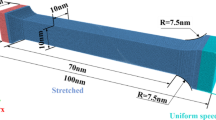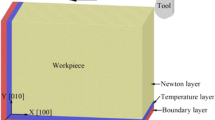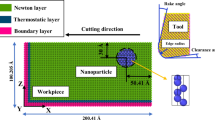Abstract
This article focuses on the establishment of a cutting force calculation model in terms of nano-scale orthogonal cutting, and investigates the stress–strain distribution of single-crystal copper that occurs in terms of nano cutting. The cutting force that occurs during the nano-scale cutting of single-crystal copper, and also its changes under different situations, can be found in this study. The molecular dynamics (MD) model was proposed to evaluate the displacement components of the atom in any temporary situation on the nano-scale cutting. The atom and lattice were regarded as the node and element, respectively. The shape function concept of the finite element method (FEM) is used to calculate the equivalent strain of the nodal atom and element. The equivalent stress–strain relationship equation was acquired by nano-scale thin-film tensile simulation in this study, and was used to further calculate the equivalent stress that occurs under the equivalent strain. Subsequently, a stress–strain distribution during nano-scale orthogonal cutting can be acquired.
Similar content being viewed by others
References
Shimada S, Ikawa N, Ohmori G, Tanaka H, Uchikoshi J (1990) Molecular dynamics analysis as compared with experimental results of micromachining. Annals CIRP 41(1):117–120
Childs THC, Maewaka K (1990) Computer-aided simulation and experimental studies of chip flow and tool wear in the turning of low alloy steels by cemented carbide tools. Wear 139(2):235–250
Belak J, Stowers IF (1990) A molecular dynamics model of the orthogonal cutting process. Proc Am Soc Precis Eng, pp 76–79
Isono Y, Tanaka T (1997) Three-dimensional molecular dynamics simulation of atomic scale precision processing using a pin tool. JSME Int J A: Mech Mater Eng 40(3):211–218
Ikawa N, Shimada S, Tanaka G, Ohmori H (1991) An atomistic analysis of nanometric chip removal as affected by tool–work interaction in diamond turning. Annals CIRP 40(1):551–554
Inamura T, Suzuki H, Takezawa N (1991) Cutting experiments in a computer using atomic models of copper crystal and a diamond tool. Int J Jpn Soc Precis Eng 25(4):259–266
Inamura T, Takezawa N, Taniguchi N (1992) Atomic-scale cutting in a computer using crystal models of copper and diamond. Annals CIRP 41(1):121–124
Inamura T, Takezawa N, Kumaki Y (1993) Mechanics and energy dissipation in nanoscale cutting. Annals CIRP 42(1):79–82
Izumi S, Kawakami T, Sakai S (2001) Study of a combined FEM-MD method for silicon. JSME Int J A: Mech Mater Eng 44(1):152–159
Liu P, Zhang YW, Lu C (2003) A three-dimensional concurrent atomistic/continuum analysis of an epitaxially strained island. J Appl Physi 94(10):6350–6353
Lin Z-C, Huang J-C (2004) A nano-orthogonal cutting model based on a modified molecular dynamics technique. Nanotechnology 15(5):510–519
Lutsko JF (1988) Stress and elastic constants in anisotropic solids: molecular dynamics techniques. J Appl Phys 64(3):1152–1154
Schøtz J, Rasmussen T, Jacobsen KW, Nielsen OH (1996) Mechanical deformation of nanocrystalline materials. Phil Mag Lett 74(5):339–344
Iwaki T (1996) Molecular dynamics study on stress–strain in very thin film (size and location of region for defining stress and strain). JSME Int J A: Mech Mater Eng 39(3):346–353
Miyazaki N, Shiozaki Y (1996) Calculation of mechanical properties of solids using molecular dynamics method. JSME Int J A: Mech Mater Eng 39(4):606–612
Haile JM (1992) Molecular dynamics simulation: elementary methods. Wiley, New York, pp 159–163
Verlet L (1968) Computer “experiments” on classical fluids. II. Equilibrium correlation functions. Phy Rev 165(1):201–214
Allen MP, Tildesley DJ (1987) Computer simulation of liquid. Clarendon, Oxford
Komanduri R, Chandrasekaran N, Raff LM (1998) Effect of tool geometry in nanometric cutting: an MD simulation approach. Wear 219:84–97
Ye YY, Biswas R, Morris JR, Bastawros A, Chandra A (2003) Molecular dynamics simulation of nanoscale machining of copper. Nanotechnology 14(3):390–396
Lin Z-C, Huang J-C (2004) A study on a rigid body boundary layer interface force model for stress calculation and stress–strain behaviour of nanoscale uniaxial tension. Nanotechnology 15(11):1509–1518
Author information
Authors and Affiliations
Corresponding author
Rights and permissions
About this article
Cite this article
Lin, ZC., Chen, ZD. & Huang, JC. Establishment of a cutting force model and study of the stress–strain distribution in nano-scale copper material orthogonal cutting. Int J Adv Manuf Technol 33, 425–435 (2007). https://doi.org/10.1007/s00170-006-0480-z
Received:
Accepted:
Published:
Issue Date:
DOI: https://doi.org/10.1007/s00170-006-0480-z




